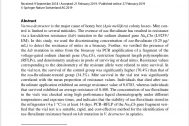Obsah
Varroa destructor is the major cause of honey bee (Apis mellifera) colony losses. Mite control is limited to several miticides. The overuse of tau-fluvalinate has resulted in resistance via a knockdown resistance (kdr) mutation in the sodium channel gene Na V Chs (L925V/I/M). In this study, we used the discriminating concentration of tau-fluvalinate (0.25 μg/mL) to detect the resistance of mites in a bioassay. Further, we verified the presence of the kdr mutation in mites from the bioassay via PCR amplification of a fragment of the voltage-gated sodium channel gene (Na V Ch), restriction fragment length polymorphisms (RFLPs), and ensitometry analyses in pools of surviving or dead mites. Resistance values corresponding to the densitometry of the resistant allele were related to mite survival. In the vial test, the survival of the control group was significantly higher (70.4%) than that of the tau-fluvalinate-treated group (34.3%). Mite survival in the vial test was significantly correlated with the mean proportion of resistance values. Individuals that died after tau-fluvalinate application exhibited an average resistance value of 0.0783, whereas individuals that survived exhibited an average resistance of 0.400. The concentration of tau-fluvalinate in the vials was checked using high performance liquid chromatography under different temperatures and exposure times, and indicates that the stability of tau-fluvalinate stored in the refrigerator (4 ± 1 °C) is at least 14 days. PCR–RFLP of the Na V Ch gene fragment verified that the vial test is a suitable, rapid, and cost-effective method for the identification of tau-fluvalinate resistance based on kdr mutation in V. destructor in apiaries.



